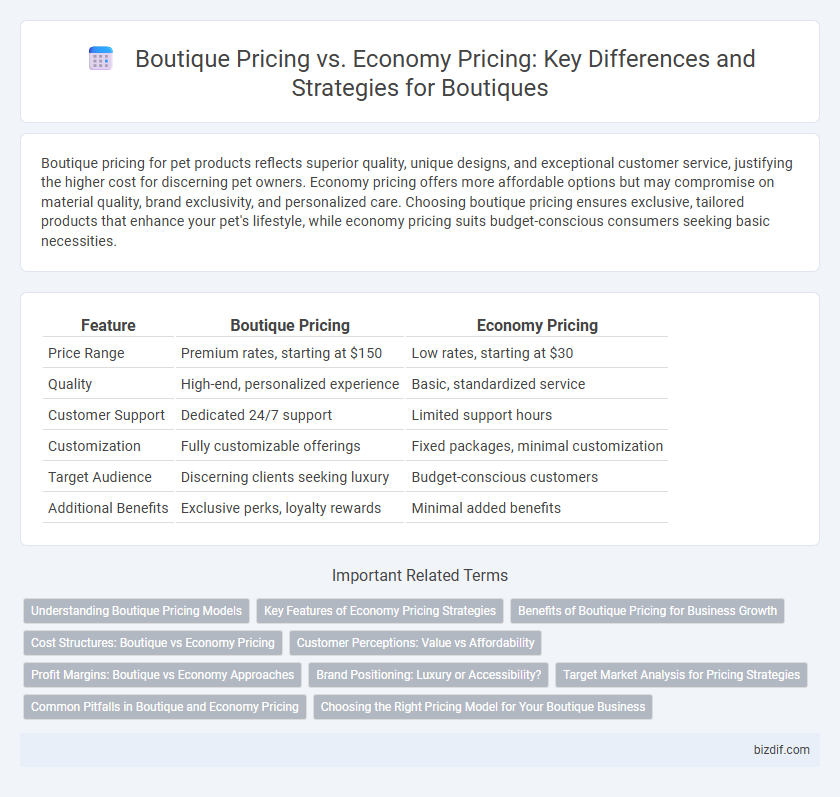Boutique pricing for pet products reflects superior quality, unique designs, and exceptional customer service, justifying the higher cost for discerning pet owners. Economy pricing offers more affordable options but may compromise on material quality, brand exclusivity, and personalized care. Choosing boutique pricing ensures exclusive, tailored products that enhance your pet's lifestyle, while economy pricing suits budget-conscious consumers seeking basic necessities.
Table of Comparison
| Feature | Boutique Pricing | Economy Pricing |
|---|---|---|
| Price Range | Premium rates, starting at $150 | Low rates, starting at $30 |
| Quality | High-end, personalized experience | Basic, standardized service |
| Customer Support | Dedicated 24/7 support | Limited support hours |
| Customization | Fully customizable offerings | Fixed packages, minimal customization |
| Target Audience | Discerning clients seeking luxury | Budget-conscious customers |
| Additional Benefits | Exclusive perks, loyalty rewards | Minimal added benefits |
Understanding Boutique Pricing Models
Boutique pricing models emphasize personalized services, exclusive products, and unique customer experiences, often resulting in higher price points compared to economy pricing. These models leverage brand differentiation, limited availability, and superior quality to justify premium charges. Understanding boutique pricing involves recognizing its focus on value creation through customization and niche targeting rather than competing solely on cost.
Key Features of Economy Pricing Strategies
Economy pricing strategies emphasize low production and marketing costs to offer products at the most affordable prices, targeting cost-conscious customers. Key features include minimal product differentiation, reduced advertising expenses, and streamlined packaging to maintain low price points. This approach contrasts sharply with boutique pricing, which prioritizes exclusivity and premium value over cost savings.
Benefits of Boutique Pricing for Business Growth
Boutique pricing allows businesses to offer premium, tailored products or services that justify higher price points and attract discerning customers seeking unique value. This strategy enhances brand perception and fosters customer loyalty, leading to increased profit margins and sustainable business growth. By differentiating from economy pricing, boutique pricing leverages exclusivity and quality, driving long-term market positioning and competitive advantage.
Cost Structures: Boutique vs Economy Pricing
Boutique pricing typically involves higher cost structures due to personalized services, premium materials, and limited production runs, which drive up overhead expenses. Economy pricing relies on streamlined operations, bulk purchasing, and cost efficiencies to minimize expenses and offer lower prices. Understanding these cost structure differences is essential for businesses to strategically position pricing models based on target customer segments and value propositions.
Customer Perceptions: Value vs Affordability
Boutique pricing often conveys a sense of exclusivity and high value, attracting customers who prioritize unique, high-quality products or personalized services. Economy pricing emphasizes affordability and cost savings, appealing to budget-conscious consumers seeking basic functionality without premium features. Customer perceptions hinge on whether the purchase is viewed as an investment in quality and experience or a practical decision driven by price sensitivity.
Profit Margins: Boutique vs Economy Approaches
Boutique pricing strategies typically yield higher profit margins due to their focus on exclusivity, premium quality, and personalized customer experiences, allowing businesses to charge premium prices. In contrast, economy pricing relies on high sales volume with minimal markups, resulting in thinner profit margins but potentially larger overall revenue. Understanding these differences helps businesses align their pricing models with market positioning and target customer expectations.
Brand Positioning: Luxury or Accessibility?
Boutique pricing emphasizes exclusivity and premium quality, reinforcing a luxury brand positioning that appeals to discerning customers seeking unique, handcrafted products or services. Economy pricing prioritizes affordability and volume, aligning with accessibility and mass-market appeal to attract cost-conscious consumers. The choice between boutique and economy pricing shapes brand identity, influencing perceived value and customer loyalty within targeted market segments.
Target Market Analysis for Pricing Strategies
Boutique pricing targets niche markets seeking exclusive products or personalized service, enabling premium pricing justified by superior quality and brand differentiation. Economy pricing appeals to mass markets with price-sensitive consumers, emphasizing affordability and volume sales to maintain competitiveness. Effective target market analysis involves assessing consumer behavior, purchasing power, and value perception to align pricing strategies with market segment expectations.
Common Pitfalls in Boutique and Economy Pricing
Boutique pricing often faces pitfalls such as overpricing due to perceived exclusivity, which can alienate price-sensitive customers, while economy pricing risks undercutting perceived value and quality, leading to diminished brand reputation. Both approaches suffer from misalignment with target market expectations, resulting in lost sales or brand dilution. Effective pricing strategies require balancing perceived value, competitive analysis, and customer segmentation to avoid these common errors.
Choosing the Right Pricing Model for Your Boutique Business
Selecting the right pricing model for your boutique business involves evaluating customer expectations, product uniqueness, and market positioning. Boutique pricing often justifies higher prices through exclusive, high-quality products and personalized services, appealing to niche markets. Economy pricing prioritizes affordability and volume sales, attracting price-sensitive customers but potentially sacrificing brand exclusivity and perceived value.
Boutique Pricing vs Economy Pricing Infographic

 bizdif.com
bizdif.com